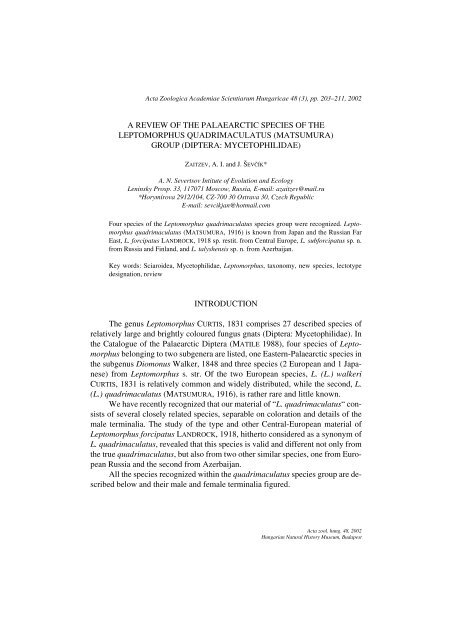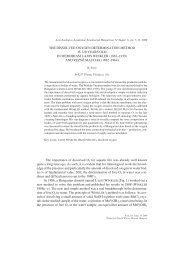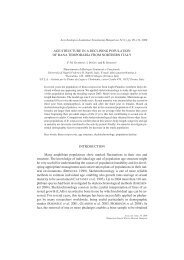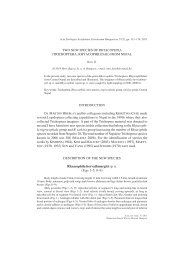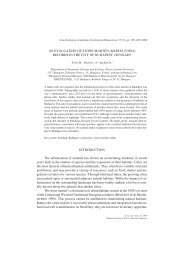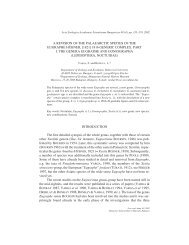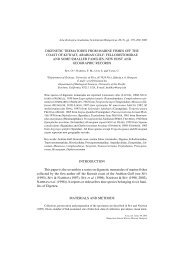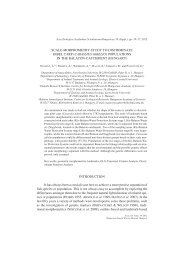leptomorphus quadrimaculatus - Acta Zoologica Academiae ...
leptomorphus quadrimaculatus - Acta Zoologica Academiae ...
leptomorphus quadrimaculatus - Acta Zoologica Academiae ...
Create successful ePaper yourself
Turn your PDF publications into a flip-book with our unique Google optimized e-Paper software.
<strong>Acta</strong> <strong>Zoologica</strong> <strong>Academiae</strong> Scientiarum Hungaricae 48 (3), pp. 203–211, 2002<br />
A REVIEW OF THE PALAEARCTIC SPECIES OF THE<br />
LEPTOMORPHUS QUADRIMACULATUS (MATSUMURA)<br />
GROUP (DIPTERA: MYCETOPHILIDAE)<br />
ZAITZEV, A. I. and J. ŠEVČÍK*<br />
A. N. Severtsov Intitute of Evolution and Ecology<br />
Leninsky Prosp. 33, 117071 Moscow, Russia, E-mail: azaitzev@mail.ru<br />
*Horymírova 2912/104, CZ-700 30 Ostrava 30, Czech Republic<br />
E-mail: sevcikjan@hotmail.com<br />
Four species of the Leptomorphus <strong>quadrimaculatus</strong> species group were recognized. Leptomorphus<br />
<strong>quadrimaculatus</strong> (MATSUMURA, 1916) is known from Japan and the Russian Far<br />
East, L. forcipatus LANDROCK, 1918 sp. restit. from Central Europe, L. subforcipatus sp. n.<br />
from Russia and Finland, and L. talyshensis sp. n. from Azerbaijan.<br />
Key words: Sciaroidea, Mycetophilidae, Leptomorphus, taxonomy, new species, lectotype<br />
designation, review<br />
INTRODUCTION<br />
The genus Leptomorphus CURTIS, 1831 comprises 27 described species of<br />
relatively large and brightly coloured fungus gnats (Diptera: Mycetophilidae). In<br />
the Catalogue of the Palaearctic Diptera (MATILE 1988), four species of Leptomorphus<br />
belonging to two subgenera are listed, one Eastern-Palaearctic species in<br />
the subgenus Diomonus Walker, 1848 and three species (2 European and 1 Japanese)<br />
from Leptomorphus s. str. Of the two European species, L. (L.) walkeri<br />
CURTIS, 1831 is relatively common and widely distributed, while the second, L.<br />
(L.) <strong>quadrimaculatus</strong> (MATSUMURA, 1916), is rather rare and little known.<br />
We have recently recognized that our material of “L. <strong>quadrimaculatus</strong>“ consists<br />
of several closely related species, separable on coloration and details of the<br />
male terminalia. The study of the type and other Central-European material of<br />
Leptomorphus forcipatus LANDROCK, 1918, hitherto considered as a synonym of<br />
L. <strong>quadrimaculatus</strong>, revealed that this species is valid and different not only from<br />
the true <strong>quadrimaculatus</strong>, but also from two other similar species, one from European<br />
Russia and the second from Azerbaijan.<br />
All the species recognized within the <strong>quadrimaculatus</strong> species group are described<br />
below and their male and female terminalia figured.<br />
<strong>Acta</strong> zool. hung. 48, 2002<br />
Hungarian Natural History Museum, Budapest
204 ZAITZEV, A. I. & J. ŠEVČÍK<br />
MATERIAL AND METHODS<br />
Altogether 39 specimens (both dried and stored in ethanol) from institutional and private collections<br />
have been examined. Male and female terminalia were macerated and cleared in 10 per cent<br />
potassium hydroxide, neutralized in acetic acid and placed in a pinned microvial filled with glycerol,<br />
or were left in ethanol. The terminology principally follows SÖLI (1997).<br />
Collections examined: IEE – A. N. Severtsov Institute of Ecology and Evolution, Moscow,<br />
Russia; MMB – Moravian Museum, Brno, Czech Republic; JŠ– Collection of JAN ŠEVČÍK, Ostrava,<br />
Czech Republic; PCH – Collection of PETER CHANDLER, Melksham, United Kingdom.<br />
SURVEY OF THE PALAEARCTIC SPECIES OF THE L.<br />
QUADRIMACULATUS GROUP<br />
Leptomorphus forcipatus LANDROCK, 1918 sp. restit.<br />
(Figs 7, 10, 15–18)<br />
Leptomorphus forcipatus LANDROCK, 1918: 107 (as var. of walkeri CURTIS, 1831).<br />
Type material examined. Lectotype (herewith designated) m, labelled: “Árvaváralja” (= Slovakia,<br />
Oravský Podzámok, District Dolný Kubín), “Kertész”, “24.vi.1914” (reverse of the same label),<br />
“Collectio K. Landrock, K Czižek, D. Jacentkovský” (MMB). The lectotype is designated to<br />
elucidate the identity and fix the status of this species.<br />
Other material examined. Czech Republic, Bohemia, Šumava Mts., Rokytská slať, peat-bog,<br />
16.6.–21.7.1999, 1 m, M. Barták & Š. Kubík leg., Malaise trap (JŠ); Moravia & Silesia, Hrubý<br />
Jeseník Mts, Vrbno pod Pradědem env., Jelení Bučina Nature Reserve, maple-beech forest,<br />
21.7.–24.9.1998, 1 m, yellow dishes filled with ethylene glycol (JŠ); Podyjí National Park, Horní<br />
Břečkov, 27.5.–7.6.2001, 1 m, M. Barták & Š. Kubík leg., Malaise trap (JŠ); Suchdol nad Odrou,<br />
Suchdolský les forest, 24.7.2002, 1 m, ex larva, collected on the lower side of Stereum subtomentosum<br />
(JŠ); Šilheřovice, Černý les Nature Reserve, beech forest, 1.–16.6.1998, 2 mm, yellow dishes<br />
filled with ethylene glycol (JŠ, IEE). Poland, Cisna, 19.9.1991, 1 m, A. E. Stubbs leg. (PCH).<br />
Slovakia, Bukovské vrchy Mts, Nová Sedlica, 24.8.2001 (ex 26.8.2001), 1 m 1 f in copula, reared<br />
from pupae collected on the lower side of Stereum hirsutum (JŠ); Bukovské vrchy Mts, Uličské<br />
Krivé, Rožok National Nature Reserve, virgin beech forest, 23.8.–14.10.2001, 1 m, yellow dishes<br />
filled with ethylene glycol (JŠ).<br />
Description. Male. Head mostly brown, clypeus light brown with long pale setae, palpus yellow.<br />
Antenna: flagellum dark brown, scapus yellow, pedicel brownish yellow, sixth flagellomere twice<br />
as long as broad. Thorax two-coloured, mesonotum with three dark brown wide longitudinal stripes,<br />
front corners, lateral and hind margins of mesonotum yellow, with dark oval spot above base of wing.<br />
Scutellum yellowish, dorsocaudally brown. Mediotergite yellow with brown medial posterior area.<br />
Laterotergite and preepisternum 2 yellowish, with ventral margin brown. Wing length 7.6 – 7.8 mm,<br />
wing with dark central spot, extending from Sc to stem of M fork, preapical band extending back to<br />
wing margin, clouds present also between branches of Cu fork and behind Cu2, stem of M fork 3<br />
times as long as rm, base of Cu fork before base of r-m. Halteres yellow with brown knobs. Legs yellowish,<br />
first tarsomere 1.7 times as long as fore tibia, fore tibia with 9–10 a, 4–6 d, 5 pd, 7–8 p, 5–9 pv,<br />
<strong>Acta</strong> zool. hung. 48, 2002
A REVIEW OF THE LEPTOMORPHUS QUADRIMACULATUS SPECIES GROUP (DIPTERA) 205<br />
Figs 1–6. Leptomorphus WALK.: 1, 3 – L. <strong>quadrimaculatus</strong> (Russia, Lazo); 2, 6 – L. subforcipatus sp.<br />
n. (holotype); 4, 5 – L. talyshensis sp. n. (holotype): 1, 4, 6 = male terminalia (dorsal view); 2, 3, 5 =<br />
gonostylus (ventral view)<br />
<strong>Acta</strong> zool. hung. 48, 2002
206 ZAITZEV, A. I. & J. ŠEVČÍK<br />
numerous v, arranged in 2 irregular rows; mid tibia with 9–12 a, 6 d, 7–11 pd, 9–10 p, 3–5 pv, 4–7 v;<br />
hind tibia with 9–14 a, 11–13 d, 12–13 pd, 11–12 p, 7 v, 4–7 av. Abdomen brownish yellow, apically<br />
darker. Tergites 1 to 6 brownish yellow, T2 basally brown, T6 caudally brown, T7 dark brown.<br />
Terminalia yellow (Figs 7, 10, 15, 16).<br />
Female. Similar to male in coloration. Terminalia yellow (Figs 17, 18).<br />
Distribution. This species is reliably known only from the Czech Republic, Slovakia and Poland.<br />
At present, there is no voucher specimen of L. forcipatus from Hungary (MATILE 1988, erroneously<br />
recorded by PAPP &ŠEVČÍK 2001) and the records (both as L. <strong>quadrimaculatus</strong>) from<br />
Switzerland (CHANDLER 1998) and Russian Karelia (POLEVOI 2001) should be verified.<br />
Biology. Larva found on the lower side of the fruit body of Stereum hirsutum and S. subtomentosum,<br />
where also pupation takes place. The mating was observed immediately after emerging from<br />
pupa and lasted several hours (in the laboratory conditions).<br />
Remarks. L. forcipatus is close to L. subforcipatus sp. n., from which it differs<br />
in the shape of gonostylus. We prefer to designate the specimen from LAND-<br />
ROCK’s collection as a lectotype, because LANDROCK (1918) did not state the number<br />
of specimens examined. The lectotype male is from northeastern Slovakia, not<br />
Hungary as considered by previous authors. The lectotype differs slightly from the<br />
other specimens, mainly in the shape of caudal margin of T9, but it is probably only<br />
intraspecific variability.<br />
Leptomorphus <strong>quadrimaculatus</strong> (MATSUMURA, 1916)<br />
(Figs 1, 3, 8, 12)<br />
Boletina <strong>quadrimaculatus</strong> MATSUMURA, 1916: 440;<br />
Lepitomorphus 4-maculata, OKADA, 1936: 99 (lapsus calami);<br />
Lepitomorphus 4-maculatus, OKADA, 1939: 302.<br />
Material examined. Russia: Primorsky Reg., Lazo, Sokolchi, 11.VII.1979, 5 mm,4ff, Zaitzev<br />
leg.; the same data, 21.VII.1979, 1.VIII.1979, 2 mm, Zaitzev leg.; Primorsky Reg., Kedrovaya<br />
Pad Reserve, IX.1960, 1 m, 1f, Krivosheina leg.; Khabarovsky Reg., Bychikha, 3.VII.1975, 1 m,<br />
Mamaev leg.; Tuva, Ishtii-Hem, 13.VIII.1979, 1 m, Krivosheina leg. (IEE).<br />
Description. Male. Head dark brown, palpus yellow; antenna dark brown, sixth flagellar segment<br />
twice as long as broad. Thorax dark brown, mesonotum shining. Wing length 6.5–8 mm, wing<br />
with dark central spot extending from Sc to stem of M fork, preapical band extending back to wing<br />
margin, clouds present also between branches of Cu fork and behind Cu2; stem of M fork 2.5 times as<br />
long as rm, base of Cu fork before base of rm. Halteres with brownish knobs. Legs yellow, basal parts<br />
of first and hind coxae dark, first basitarsus twice as long as fore tibia; fore tibia with 14–15 a, 6–7 d,<br />
7–12 pd, 12–14 p, numerous v, arranged in irregular rows; mid tibia with 14–15 a, 11–13 d, 14–21 pd,<br />
14 p, 5–8 v, 10–11 av; hind tibia 19–20 a, 18–21 d, 21–23 pd, 18–20 p, 7–10 pv, 14 v. Abdomen shining<br />
dark brown. Terminalia brown.<br />
Female. Similar to male in coloration. Ovipositor light brown, cerci yellow.<br />
<strong>Acta</strong> zool. hung. 48, 2002
A REVIEW OF THE LEPTOMORPHUS QUADRIMACULATUS SPECIES GROUP (DIPTERA) 207<br />
Figs 7–10. Leptomorphus WALK.: 7, 10 – L. forcipatus (Czech Republic, Šilheřovice); 8 – L. <strong>quadrimaculatus</strong><br />
(Russia, Lazo); 9 – L. subforcipatus sp. n. (Russia, Moscow region): 7 = male terminalia<br />
(dorsal view); 8, 9 – female terminalia (lateral view); 10 = gonostylus (ventral view)<br />
<strong>Acta</strong> zool. hung. 48, 2002
208 ZAITZEV, A. I. & J. ŠEVČÍK<br />
Leptomorphus subforcipatus sp. n.<br />
(Figs 2, 6, 9, 13)<br />
Leptomorphus forcipatus, KRIVOSHEINA, ZAITZEV, YAKOVLEV, 1986, fig. 36, 6;<br />
Leptomorphus <strong>quadrimaculatus</strong>, ZAITZEV, 1994 (part), fig. 54, 4; Zaitzev, 1999, fig. 99, 5.<br />
Material examined. Holotype m: Russia, Moscow Reg., Pavlovskaya Sloboda, 10.VII.1982,<br />
Zaitzev leg. (IEE). Paratypes. Russia: 4 mm,1f, with the same data; 3 mm, Moscow Prov., Ovrazhki,<br />
30.VII.1984, Zaitzev leg.; 1 m, Moscow Reg., Anikeevka, 15.IX.1982, Zaitzev leg.; 1 m, Kostroma<br />
Prov., Ugory, 8.IX.1981, Zaitzev leg.; 1 m, Karelia, Tolvoyarvi, 29.VI–2.VII.1998, Tietäväinen leg.;<br />
Finland, 1 m, Ilomantsi, Tapionaho, 7–28.VII. 1993, Yakovlev leg. (IEE).<br />
Description. Male. Head dark brown, clypeus light brown or yellow, palpus yellow; antenna<br />
dark brown, scapus and pedicel yellow, sixth flagellar segment twice as long as broad. Thorax twocoloured,<br />
mesonotum shining dark brown with yellow hind corners, scutellum brown, mediotergite<br />
yellow with brown central area, laterotergite yellowish brown. Wing length 6–8 mm, wing with dark<br />
Figs 11–14. Leptomorphus WALK.: 11, 14 – L. talyshensis sp. n. (paratype); 12 – L. <strong>quadrimaculatus</strong><br />
(Russia, Lazo); 13 – L. subforcipatus sp. n. (Russia, Moscow region): 11–13 = female sternite 8 (ventral<br />
view); 14 = female terminalia (lateral view)<br />
<strong>Acta</strong> zool. hung. 48, 2002
A REVIEW OF THE LEPTOMORPHUS QUADRIMACULATUS SPECIES GROUP (DIPTERA) 209<br />
central spot, extending from Sc to stem of M fork, preapical band extending from Sc to stem of M<br />
fork, preapical band extending back to wing margin, clouds present also between branches of Cu fork<br />
and behind Cu2, stem of M fork 2.5 times as long as rm, base of Cu fork before base of rm. Halteres<br />
with brownish knobs. Legs yellow, first tarsomere 1.5 times as long as fore tibia, fore tibia with 9–10<br />
Figs 15–18. Leptomorphus forcipatus LANDROCK: 15–16 = lectotype, male terminalia: 15 = tergite 9<br />
(dorsal view); 16 = gonostylus (ventral view); 17–18 = Slovakia, Nová Sedlica, female terminalia:<br />
17 = lateral view; 18 = sternite 8 (ventral view)<br />
<strong>Acta</strong> zool. hung. 48, 2002
210 ZAITZEV, A. I. & J. ŠEVČÍK<br />
a, 4–6 d, 5 pd, 7–8 p, 5–9 pv, numerous v, arranged in 2 irregular rows; mid tibia with 9–12 a, 6 d,<br />
7–11 pd, 9–10 p, 3–5 pv, 4–7 v; hind tibia with 9–14 a, 11–13 d, 12–13 pd, 11–12 p, 7 v, 4–7 av. Abdomen<br />
brown. Terminalia yellowish brown.<br />
Female. Similar to male in coloration. Ovipositor yellow.<br />
Remark. This species is very close to L. <strong>quadrimaculatus</strong> (MATSUMURA),<br />
from which it differs in the coloration of thorax and in the shape of gonostylus.<br />
Leptomorphus talyshensis sp. n.<br />
(Figs 4, 5, 11, 14)<br />
Material examined. Holotype m: Azerbaijan, Avrora, 13.V.1980, Zaitzev leg. Paratypes: m, f,<br />
with the same data (IEE).<br />
Description. Male. Head yellow, vertex light brown, clypeus and palpus yellow, antennae with<br />
sixth flagellar segment twice as long as broad. Thorax two-coloured; mesonotum shining dark brown<br />
with yellow lateral parts, laterotergite yellow with brownish lower margin, pleuron yellow. Wing<br />
length 7 mm, wing with dark central spot, starting from Sc and ending behind stem of M fork, apical<br />
part of wing darkened, clouds present also between branches of Cu fork and behind Cu2; stem of M<br />
fork 3.5 times as long as rm, base of Cu fork under base of rm. Halteres with brown knobs. Legs yellow,<br />
first tarsomere twice as long as fore tibia, fore tibia with 6–8 a, 2 d, 1–3 pd, 5 p, 6 pv, 15 v; mid<br />
tibia with 16 a, 8 ad, 5 d, 8 pd, 6 p, 3–4 v; hind tibia with 8 a, 10 ad, 8 d, 6 pd, 4 p, 4 v. Abdomen<br />
two-coloured, tergites 1–5 yellow with dark brown hind margins, tergite 6 dark brown with narrow<br />
yellow fore margin. Terminalia yellow.<br />
Female. Similar to male in coloration. Ovipositor yellow.<br />
Remarks. This species is close to L. forcipatus LANDROCK, from which it differs<br />
mainly in the coloration of abdomen and in the shape of gonostylus.<br />
KEY TO SPECIES<br />
1 Wing with dark central spot extending from Sc to stem of M fork and preapical<br />
band extending back to wing margin. Base of Cu fork before base of rm.<br />
Abdomen shining dark brown 2<br />
– Wing with dark central spot starting from Sc and ending behind stem of M<br />
fork. Base of Cu fork under base of rm. Abdomen two-coloured, tergites 1–5<br />
yellow with dark brown hind margins. Male terminalia as on Figs 4, 5; ovipositor<br />
as on Figs 11, 14 L. talyshensis sp. n.<br />
2 Thorax unicolorous dark brown. Male terminalia as on figs 1, 3; ovipositor as<br />
on Figs 8, 12 L. <strong>quadrimaculatus</strong> (MATSUMURA)<br />
<strong>Acta</strong> zool. hung. 48, 2002
A REVIEW OF THE LEPTOMORPHUS QUADRIMACULATUS SPECIES GROUP (DIPTERA) 211<br />
– Thorax two-coloured, mesonotum dark brown with yellow hind corners,<br />
pleurae yellow or light brown, mediotergite yellow with brownish central<br />
area 3<br />
3 Gonostylus with distinct triangular projection directed medially (Fig. 2)<br />
L. subforcipatus sp. n.<br />
– Gonostylus without triangular projection directed medially (Fig. 10)<br />
L. forcipatus LANDROCK<br />
*<br />
Acknowledgement – We are grateful to PETER CHANDLER (Melksham, U.K.) for useful comments<br />
on the manuscript.<br />
REFERENCES<br />
CHANDLER, P. J. (1998) Mycetophilidae. In: MERZ, B., BÄCHLI, G., HAENNI, J.-P. & GONSETH,Y.<br />
(eds): Diptera – Checklist. Fauna Helvetica 1: 113 – 125; Neuchâtel: Centre suisse de cartographie<br />
de la faune & Sweizeirische Entomologische Gesellschaft.<br />
KRIVOSHEINA, N. P., ZAITZEV, A.I.&YAKOVLEV, E. B. (1986) Insects as decomposers of fungi<br />
inforests of the European part of the USSR. Moscow, Nauka. 309 pp. [in Russian]<br />
LANDROCK, K. (1918) Tabellen zum Bestimmen europäischen Pilzmücken. II. Wien. ent. Ztg. 37:<br />
107–120.<br />
MATILE, L. (1988) Tribe Sciophilini. Pp. 231–241. In SOÓS, A.&PAPP, L. (eds) Catalogue of<br />
Palaearctic Diptera. Vol. 3. Hungarian Natural History Museum, Akademiai Kiadó, Budapest.<br />
MATSUMURA, S. (1916) Thousand insects of Japan. Addimenta 2. (Diptera). pp. 185–473.<br />
OKADA I. (1936) Einige Nematoceren aus der Süd-Kurilen (Diptera). Insecta Matsumurana 10:<br />
99–103.<br />
OKADA, I. (1939) Studien über die Pilzmücken (Fungivoridae) aus Hokkaido (Diptera, Nematocera).<br />
J. Fac. Agr., Hokkaido Imp. Univ., Sapporo 42(4): 267–336.<br />
PAPP, L.&ŠEVČÍK, J. (2001) Mycetophilidae. Pp. 128–142. In PAPP, L. (ed.): Checklist of the<br />
Diptera of Hungary. Hungarian Natural History Museum, Budapest. 550 pp.<br />
POLEVOI, A. V. (2001) New and little known species of the fungus gnat subfamilies Mycomyinae<br />
and Sciophilinae (Diptera, Mycetophilidae) from Eastern Fennoscandia. Entomol. Obozr.<br />
80(2): 518–526.<br />
SÖLI, G. E. E (1997) The adult morphology of Mycetophilidae (s. str.), with a tentative phylogeny of<br />
the family (Diptera, Sciaroidea). Ent. Scand. Suppl. 50: 5–55.<br />
ZAITZEV, A. I. (1994) Fungus gnats of the fauna of Russia and adjacent regions. Part. I. Moscow,<br />
Nauka, 287 pp. [in Russian]<br />
ZAITZEV, A. I. (1999) Fam. Mycetophilidae – Fungus gnats. Key to the insects of Russian Far East.<br />
Vol. VI. Diptera and Siphonaptera. Pt. 1. Vladivostok, Dal’nauka, pp. 151–239. [in Russian]<br />
Received May 31, 2002, accepted December 16, 2002, published January 15, 2003<br />
<strong>Acta</strong> zool. hung. 48, 2002


